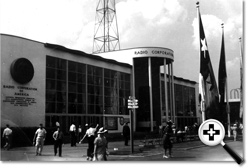A new form of radio transmitting called FM was demonstrated to the public for the first time in the RCA building. The exhibit was lit with the new fluorescent lighting and a new invention, called the facsimile (FAX) machine transmitted 8-inch by 12-inch newspaper pages at a rate of eighteen minutes per page.
A television made from Dupont's new material, Lucite, was in the lobby. The walk-through exhibit of the yacht was in a garden in the rear of the RCA pavilion.

photo 196 by Arie van Dort

Courtesy of Bob Catania

click the image to read the newpaper
Courtesy of Bob Catania

Rip Van Winkle wakes for a tour of the RCA building. 1939
The story of R.C.A.


The pavilion was shaped like a huge radio tube attached to a base, with the base forming the front section of the building. The tube proper, at the rear, housed the television exhibit.
The RCA baby carriage exhibit in the pavilion’s foyer was meant to prevent kidnapping of the youngsters (certainly a response to the horrific Lindbergh kidnapping earlier in the decade). If the “baby” was removed, an activated voice cried, “Call all parents!” After a naming contest won by Mrs. J. R. Claesson, the dummy baby was called “Letta Alone.”
Even though the Fair’s second day attendance dropped dramatically, the RCA pavilion continued as a major draw with the innovation of television.
The pavilion displayed the “Room of Tomorrow,” meant to highlight a family’s use of the newly developed television. John Vassos, and industrial designer, prepared a “functional” room that included not only the television, but, also, a radio, phonograph, facsimile and moving picture units. The blue carpet complimented the contrasting cool and warm shaded walls and the rosewood furniture.
RCA generated seventy-two hours of live programming each week from its pavilion. Visitors could be part of the daily television broadcasts. Young ladies, known collectively as Miss Television, assisted scores of willing subjects through the intricacies of the new art form.
It was soon discovered that women were somewhat reluctant to appear before the television cameras. Most insisted on applying extra makeup, disregarding the technician’s advice that “television lights the natural facial coloring best.”
The initial two-hour live broadcast of the Fair’s opening ceremonies, including FDR’s speech, taught the young industry three important lessons: one camera was not sufficient to cover large outdoor events, the cameras must “roam around” during speeches to keep the audience’s attention and telecasters needed to talk less and let the pictures do the explanation (obviously a hold-over from radio commentary).
RCA displayed a 53-foot Elco motor yacht to demonstrate the latest in marine safety and communications. The walk-through exhibit of the yacht was in a garden in the rear of the RCA pavilion.

photo 052 by Arie van Dort
Some information from Monte Abramson
The Electric Boat Company's prototype of the Elco 53' (in 1940 six 57-foot yachts were built) was used in the pool. RCA showed ship-to-shore radio for the first time aboard the Elco.The receiver for the ship-to-shore radio was located within the RCA Pavilion.
The Elco was moved to the Brooklyn Navy Yard to be transported back to Elco in New Jersey.
Howard Johnson (the restauranteur) purchased the 1939 Elco 53' from the World's Fair exhibition. He brought it to Boston and then had it motored down to Florida. Johnson named it the Do-Ho after Dorothy his wife and Howard.
In 1940, he sold the boat ( which survives and was used in the tv show Riptide). He bought a bigger Elco 57' in 1940 and called that boat Do-Ho, as well. The 1940 Do-Ho was used in WW2 by the 'Gentlemen's Navy'doing harbor patrols.
During WW2, the DO-HO was converted into a patrol boat (a deck gun was added). It, and other yachts patrolled the lower New England harbors (more as a show for the nervous locals).
In 1941, after the attack on Pearl Harbor, Elco began to build P.T. Boats for the U.S. Navy. The most famous of the Elco P.T. Boats that was built and saw action in the South Pacific during WWII was the Elco Patrol Torpedo Boat number “P.T. 109” commanded by Lieutenant JG John Fitzgerald Kennedy who later became the 35th President of the United States.
After the war it was restored into being a yacht. It is now owned by Shannon Yachts of Bristol, Rhode Island who are restoring the boat to it's original glory.
- Return to:
- Communications
- October 2017 Newsletter
